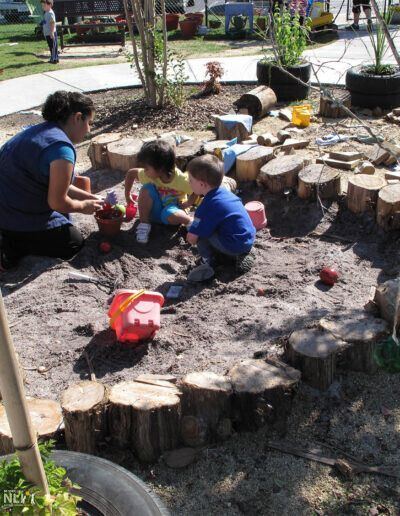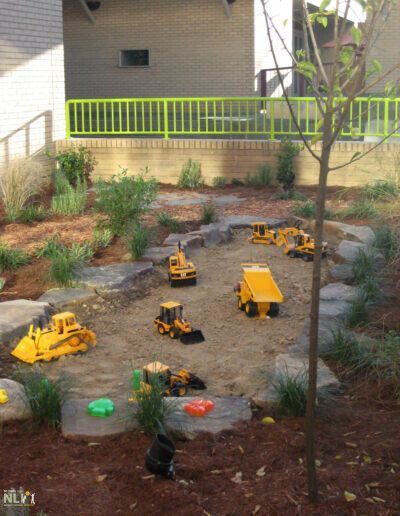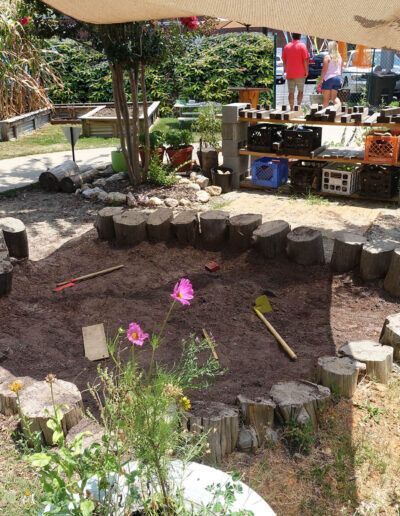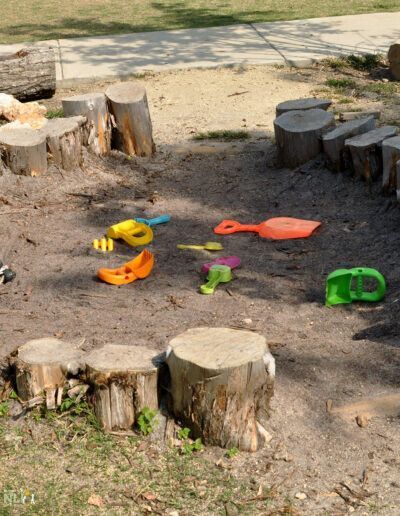33. Earth Play Settings
Earth play stimulates dramatic play and provides children with opportunities to dig and sculpt. Enclosed by logs or rocks and filled with a prepared “earth play mix,” earth play settings may contain natural loose parts or manufactured items to add play value. This low-cost play setting solution can be easily installed with a few materials and a handful of volunteers. Encourage children to get their hands dirty and explore the sensory qualities that earth play has to offer.
shape, size, and location
Earth play setting shape and size are flexible, easily aligning with the boundaries of adjacent settings. Typically, earth play settings are circular and 6–10 ft. wide. A large, flat stone in the center adds play value but may increase size.
Locate the setting. Choose flat, level ground with sufficient space to move around the setting perimeter. Locate close to a primary pathway that links to other settings and, if possible, under an existing shade tree or shade structure. If neither exists, make sure to include shade provision as part of the project.
Earth play settings are usually bounded by a continuous line of partially buried logs to create a sittable/playful setting edge, a sense of enclosure, and to keep the earth play mix from migrating. Logs can often be found for free or at low cost locally. Cedar, locust, or other hardwoods are recommended for their pest and rot-resistance.
preparing logs
To ensure child safety, any logs used as a boundary should be debarked, with all protrusions removed. Sharp upper edges should be rounded with a power sander. For more information, including how to treat the logs for longevity, refer to the InfoSheet: Gathering Settings Created with Logs.
installation
Excavate a pit 12–18 inches deep in the designated setting area. Include space for installing boundary logs.
For boundary logs, dig a trench 4 in. wider than the logs and deep enough to keep the logs stable after installation. Allow for 2 in. of pea gravel below the logs. Calculate log lengths to include 12–18 in. above grade of external ground surface. Add 2 in. of pea gravel, for drainage, to the bottom of the hole, around each log base, and behind the logs.
If the vertical logs are low in relation to the external ground surface, add treated horizontal logs, 12 inches or more in diameter, adjacent to the outside edges of the vertical logs.
Add landscape fabric, if needed, to keep native soil from mixing with the earth play mix. To install, cut fabric to the edge of the logs to cover the excavated earth surface.
Prepare earth play mix. Calculate volume required. Mix equal parts sphagnum moss and certified play sand. Play sand is graded and washed to make it safe for play. Mini pine-bark nuggets can be a substitute for spangham moss (considered a nonrenewable resource), but will take a while to break down to create an integral play matrix. All three materials are available at home improvement stores and garden centers.
Install earth play mix, 12–18 inches deep, on top of native soil or landscape fabric.
Populate with suitable “earth play toys”—dinosaurs are a favorite. Many other molded plastic animal reproductions are available to stimulate socio-dramatic nature play.
If large, smooth stones or rocks are available, they can be used instead of vertical logs as an alternative method of enclosure. Install them directly on landscape fabric and cut to the edge of excavation, which will need to be wide enough to accommodate the boundary edge. Smooth rocks or stones may be donated at low or no cost, or can be purchased from a landscape materials supplier.
Provide sufficient shade by planting small or medium sized trees adjacent to the earth play setting. As trees need to mature before providing adequate shade, consider installing a temporary shade structure or shade sail.
Plant shrubs and/or hardy perennials around the earth play setting to add sensory enhancement and a sense of enclosure.
Distribute excess soil elsewhere on the site.
health and safety
- Before digging, call 811 ahead of time to check for underground utilities. The service is free, but it can take the agency several days to verify information.
- Wear sturdy boots and gloves during installation.
- Make sure boundary logs are not more than 18 inches above surrounding grade.
- Regularly inspect logs for signs of decay. If unstable, replace before they become a possible hazard.
Materials & Tools
- Log segments and/or fieldstone
- Certified play sand
- Sphagnum Moss
- Landscape fabric (optional)
- Shade trees or shade structure
- Shovel
- Pea gravel (if installing partially buried, vertical logs)






